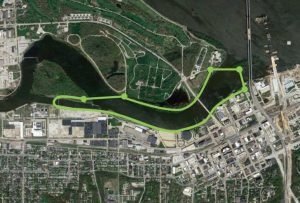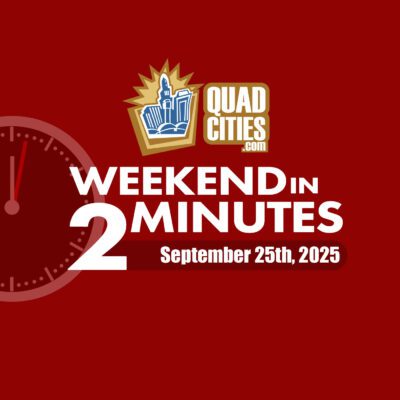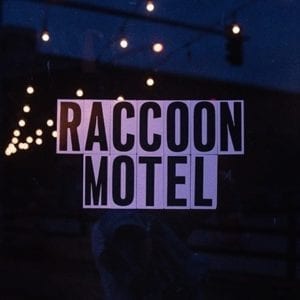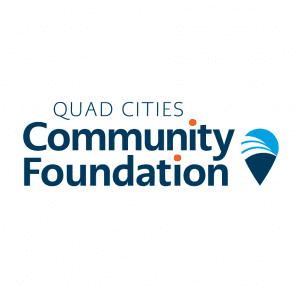Huge Water Spout? Zip Line? New Downtown Moline Report Proposes Several Big Ideas
In some hazy, halcyon future when the old I-74 bridge is gone, Moline’s riverfront will have lots of opportunity for growth and redevelopment.

The ULI panel recommends a big waterspout for downtown Moline, like the one seen here in Geneva, Switzerland (pictured in the report).
A final advisory report done for Renew Moline by the Urban Land Institute (ULI) recommends many big ideas – a new Mill Town neighborhood, Moline history museum and welcome center, much more housing, an arts district, riverfront restaurant, zip line, and a signature water spout shooting up more than 200 feet over the Mississippi River.
Creating greater connections with the river is a prime focus of the 44-page plan by Washington, D.C.-based ULI. Renew Moline, along with the City of Moline, John Deere Foundation, and MetroLINK contributed to fund technical assistance by ULI to develop a strategy surrounding the future I-74 redevelopment area. Three overarching areas of opportunity were identified: residential development, connecting the city to the river and creating an arts district.
To complete the report, The Urban Land Institute convened a panel of development experts in a variety of disciplines, including retail market assessment, housing development, finance, economic/community development and urban design.

The cover of the Urban Land Institute report on Moline.
The panel was chaired by Rick Dishnica, president of The Dishnica Company, LLC, an infill housing and investment company. Other panel members were based throughout the U.S. (more about the panel can be found by clicking here). The panel was overseen by Tom Eitler, Senior Vice President of Advisory Services for ULI North America.
The advisory panel was posed a series of questions about the I-74 redevelopment area in downtown Moline, addressing matters such as future redevelopment sites, opportunities to connect to the river, and governance structures to fulfill the vision.
“I am very excited by the big ideas that ULI shared with us and the ways to get this done,” Moline Mayor Sangeetha Rayapati said Tuesday. “I am in full alignment with dreaming big and finding ways to make it happen.”
The final report can be seen on Renew Moline’s website at www.renewmoline.com.
The ULI is the oldest and largest network of cross-disciplinary real estate and land use experts in the world. Renew Moline, Inc. is the non-profit economic development entity planning for the future, facilitating development, connecting resources and people, and advocating for public policies and programs in order to realize opportunities for continued investment in and repositioning of Moline’s riverfront as the place to live, work, play and learn.
“There’s a lot in there to get excited about,” Renew president/CEO Alexandra Elias said of the report Tuesday, noting the panel had stakeholder meetings with at least 50 people for input. “We should do more with the river and the beautiful asset we have — creating new opportunities to do things on the river, orient activities we do all the time on the river. We don’t have many eating and drinking establishments on the river; we can look for more of those types of opportunities.”
“Moline can embrace its authentic identity as a city built around creating, making, and great parks and riverfront recreation,” the ULI report

Alexandra Elias is Renew Moline president/CEO.
says, noting they recommend creating a great new riverfront park that connects people to the waterfront and nature in a whole new way. “The Great River Park includes the creation of a new water feature, a basin, and more active green spaces. These elements reconnect people with the waterfront and with nature, with the Great River Trail and other trails in new, exciting ways. Moline has a great start with the KONE Centre, John Deere Commons, and good individual pieces like the Bass Street and Two Rivers YMCA rowing center and Sylvan Island.
“The panel is suggesting that these separate elements be connected with a more continuous waterfront experience. The trail can be more animated with interpretive signage, sculpture, and riverfront restaurants (café, food truck, kiosks), all of it celebrating the authentic spirit, history, friendliness, and genuine warmth of Moline,” the report says. “Consider active green space to serve the additional housing the panel is recommending. An excellent opportunity exists for this to replace a surface parking lot as a moment of arrival.”
A focal point of the report development is a planned Mill Town (Moline gets its name from the French word meaning “milltown”) neighborhood around 19th Street and River Drive. One map in the report shows several different potential features, including:
- Affordable townhomes
- A Mill Town museum and welcome center
- A zip line from river’s edge to a small island in the river
- Retail, incubator kiosks and a viewing deck
- Canal basin for water sports and ice sports
- Picnic area and restaurant
- Small boat harbor and ferry dock
- A waterspout shooting between 200 and 400 feet high
- More than 200 combined parking spaces
- Redevelopment of the vacant Spiegel Building as housing for artists and flexible art space
A “Heart of the Arts” district around the repurposed Spiegel Building “signals something new and exciting happens there,” the report says. Last fall, Renew Moline led unveiling of a new public art project (part of the downtown master plan) at the vacant Spiegel building, 200 20th St. The commissioned mural, on several ground floor panels, was done by Brandon Nees, a 25-year-old Davenport artist who graduated

The plan proposes Moline connecting its riverfront properties (highlighted in green) into a Great River Park.
from Moline High School.
He painted the word “possibility” in big turquoise block letters across seven plywood panels, among nine colorful 7.6-foot-by-6.75 feet panels he created for a $10,000 public mural on the boarded-up ground floor of the city-owned building.
One of the ULI report’s “big ideas” is to refashion Moline as a “modern maker hub by dedicating more spaces for makers, a creative arts–driven piece of the Moline economy. Moline has a tremendous history of invention and making that can inform the development of its next economy,” the report says. “It was once an outlandish idea to put an elevator into a building to move people up and down or to install a moving staircase to get from here to there. Yet these are commonplace today, thanks to the ingenuity of people from Moline.
“Let us help them discover the next outlandish idea and make it flourish. The panel does not suggest the city do all of these at once: prioritization is essential. The rewards will be great because these are all things the workforce of the future is looking for,” ULI wrote. “And to stay vibrant and healthy, Moline needs to keep reinventing jobs. Furthermore, as the world reawakens from the isolation of the COVID-19 pandemic, people will want to experience their backyards, discover each other, and reconnect with small towns—and to do this in new ways that are more equitable, inclusive, and diverse. Because of the international travelers that come to do business in Moline, the city already knows how to roll out the welcome mat for a diverse audience and it can apply those skills widely.”
The proposed Mill Town waterspout, with the appropriate height and scale, “can become an identifying landmark and a strong wayfinding statement for all of downtown Moline,” the report says. “Anyone coming to Moline will be able to identify where the river is in relation to their location. The waterspout will be visible from the new I-74 bridge and will serve as a focal interest statement to encourage people to come in and visit Moline instead of just passing through.
“Adding a zip line or water taxi connection to outdoor pedestrian and biking recreational opportunities is a critical piece of the panel’s vision, enabling access to nature, providing a place for exercise, and drawing people to the water,” the report says. “This could be a unique creator of identity and unparalleled attraction that provides an opportunity for island hopping on the Mississippi River. The zip line route to Mill Island will pass by the waterspout and become an interactive experience. Mill Island could have a fire tower at the receiving end of the zip line over the trees, which could be descended either by stairs or an elevator.”
On the 700-foot-long Mill Island (the very small island between the riverfront and Arsenal Island) itself could be nature trails, bike trails, or interactive play areas. A ferry/taxi boat dock could then take island visitors back to the Mill Town Basin or on to Rock Island to continue their tour of the Great River Trail, the report says. In the future, pedestrian and bike bridges could be added to replace or supplement the

Moline Mayor Sangeetha Rayapati
ferry or taxi.
The proposed Moline History Museum and Visitors Welcome Center would put a visitors center right off the I-74 exit coming eastward into Moline and would be a great introduction to the city, the report says. “The addition of a museum would be a wonderful opportunity for telling the history of the ‘City of Mills’ and helping set the stage for interesting places and spaces in Moline.
Recommending an adaptive re-use of the Spiegel Building would convert the top three stories to 30 residential units for artists. The panel believes the ground-floor space should be renovated and programmed for commercial, arts, and/or makerspace, the report says.
“The new Mill Town Neighborhood, which is near the area once dominated by the I-74 bridge access, affords an opportunity to create a focal point for entrepreneurial creativity, access to the Mississippi River, a variety of outdoor recreation opportunities, and a unique place for residents and visitors to gather,” ULI wrote. “Go bold, Moline!”
The report’s conclusion says that the panel perceives the community to be dysfunctional.
“It needs to build up a culture of project management and a stable development environment. A cohesive vision between the political and civic leadership does not exist to undertake such a bold and complex program of development that will play out over 10 years,” the authors wrote. “The basics of government approvals and services need to happen in a timely and efficient way.”
ULI said the city needs to build partnerships with various nonprofit and for-profit developers who share the city’s dreams and are willing to invest. To attract partners to build the housing, create the park, and accomplish the other goals will require the public sector to share the risk, the report says.
“How that happens ethically and transparently will determine the city’s success,” it says, noting improving riverfront parks should be the first priority for implementation. Elias noted there are no cost estimates in the recommendations.
“Successful leaders today share some common traits. They are curious, nimble, and have an appetite for risk,” ULI wrote. “Is that going to be Moline or is the city content to settle for the status quo? Moline invited ULI here; clearly, it wants to do more. The panel’s most important message is to dream big, get organized, and get the job done. Moline has done it before and can do it again.”
Elias gave a brief overview of the plan Tuesday to the city’s Project Management Team. She said it’s up to the mayor and city council now on how to proceed with implementing the vision. You can see the full report HERE.













Leave a Reply
You must be logged in to post a comment.